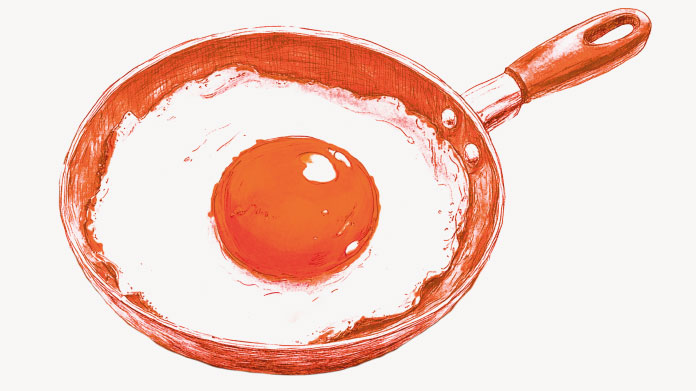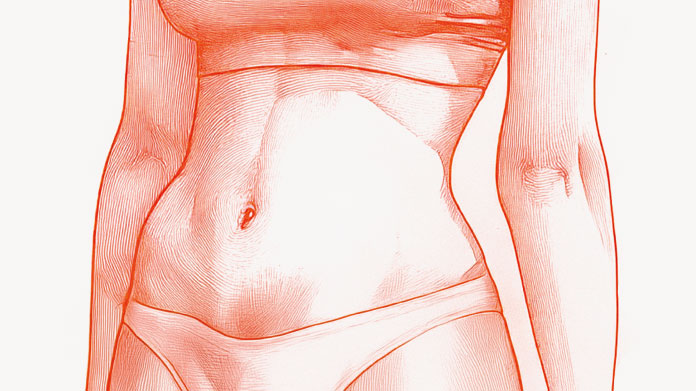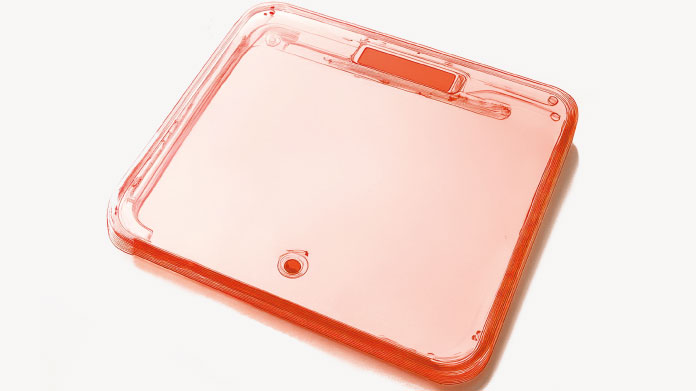
Cellulite or orange peel skin – what exactly is it?
Scientists estimate that, compared with just 50% of men, 80%-90% of women are affected by it at some point in their life (1): cellulite - which occurs most commonly on the lower body - gives skin that ‘orange peel’ appearance but this inoffensive description belies the discontent it can produce in those affected.
To understand why this ‘dimpling’ occurs, we need to remember that the skin is made up of three layers: the epidermis, the dermis and the hypodermis. It’s in the hypodermis, the innermost layer, that fat cells called adipocytes are located.
When adipocytes get too large, they are said to be hypertrophic; they compress blood and lymphatic vessels making them less effective at draining the skin. The surface of the epidermis then becomes deformed developing the characteristic orange peel ‘dimpling’: this is cellulite (2).
Adipose cellulite thus has an adverse effect on cellular metabolism and can cause constant tissue inflammation. This is why it gets confused with cellulitis (3), a bacterial skin infection which requires medical attention.
Some tips for combatting cellulite
Since cellulite is directly linked to subcutaneous accumulation of fat, it’s no surprise that reducing your body fat mass is an excellent first step to tackling unsightly orange peel skin.
We know that increased fat mass can be linked to various factors:
- poor diet: too much sugar, salt and unhealthy fats (4) ;
- stress: stress triggers the release of cortisol which promotes the accumulation of fat (5);
- a sedentary lifestyle : circulation restriction and low energy expenditure both promote cellulite;
- hormone problems: whether linked to endocrine disorders or medication (contraceptive pill, etc.) (5) ;
Regular, moderate exercise is therefore strongly recommended (see our article on exercise and health) as is adopting a healthy, balanced diet and reducing fat mass (see our articles on the paleo diet and the acid-base diet). But you might also be glad of a natural boost to help you get rid of your orange peel skin.
Coleus forskohlii for lipolysis
A tropical plant from the lamiaceae family (which also includes nettles and mint), Coleus forskohlii, or Indian coleus, is an Ayurvedic plant used in traditional medicine to alleviate a number of health problems.
Its strength lies in its most active ingredient, forskolin. This substance (which can be found in the supplement Coleus Forskohlii, standardised to 10% forskolin) is an activator of adenylate cyclase, an enzyme involved in the use of adipocytes for the body’s energy production (6). Coleus forskohlii thus helps to support weight control and the metabolism of lipids. It’s said to help enhance lipolysis, the breakdown of fatty tissue. It thus constitutes an effective aid against cellulite as it helps to ‘consume’ hypertrophic adipocytes in the hypodermis.
Malabar tamarind for weight control
With the botanical names Garcinia gummi gutta or Garcinia cambogia, Malabar tamarind is a tropical shrub that produces strange little green or yellowish pumpkin-like fruit which have been used in Ayurvedic medicine for thousands of years.
The fruit of the Malabar tamarind contains hydroxy citric acid, or HCA (which you can find in the supplement Garcinia Cambogia, standardised to 60% HCA), which supports weight control. It does this partly by promoting the release of serotonin which produces a feeling of satiety and thus helps you eat less, and partly by helping to inhibit ATP citrate lyase, thus curbing lipogenesis, the synthesis of fatty acids from glucose (7).
Ural liquorice for metabolism
Ural liquorice, also known as Chinese liquorice, is a flowering plant with the scientific name Glycyrrhiza uralensis.
Used for thousands of years in traditional Chinese medicine, Ural liquorice contains a number of active ingredients including glabridin. This helps to support metabolism and weight loss by promoting the breakdown of fats for energy production (8). You can find Ural liquorice in the supplement Viscerox.
Guarana seeds for fat metabolism
Native to Amazon regions and known to fans of energy drinks, the shrub guarana, or Paullinia cupana, produces a fruit the seeds of which have a stimulating effect.
But in addition to this benefit, much appreciated by sports enthusiasts and students looking for an ‘energy buzz’, guarana seeds also support fat metabolism and weight control, making Paullinia cupana a potent weapon against orange peel skin (9). It can be found in the supplement Water Retention Formula, combined with Meadowsweet, which itself supports skin and tissue health.
Grapevine for weight control and fighting cellulite
The plant Vitis vinifera, better known as red grapevine, has been used for millennia in phytotherapy. Leaves, seeds, fruit skin, marc (pomace): almost every part of the plant is used for treating a variety of ailments.
And red grapevine also helps to both support weight control and combat cellulite. That’s why it has been used to produce a supplement with concentrated amounts of its key active ingredient Resveratrol (10).
References
- SADICK, Neil. Treatment for cellulite. International journal of women's dermatology, 2019, vol. 5, no 1, p. 68-72.
- AVRAM, Mathew M. Cellulite: a review of its physiology and treatment. Journal of Cosmetic and Laser Therapy, 2004, vol. 6, no 4, p. 181-185.
- RAFF, Adam B. et KROSHINSKY, Daniela. Cellulitis: a review. Jama, 2016, vol. 316, no 3, p. 325-337.
- MENAT, É. Cellulite et phytonutrition. Phytothérapie, 2006, vol. 4, no 1, p. hs21-hs27.
- LESZKO, Marta. Cellulite in menopause. Przeglad menopauzalny= Menopause review, 2014, vol. 13, no 5, p. 298.
- TUNG, Yen-Chen, SHIH, Yi-Ang, NAGABHUSHANAM, Kalyanam, et al.Coleus forskohlii and Garcinia indica extracts attenuated lipid accumulation by regulating energy metabolism and modulating gut microbiota in obese mice. Food Research International, 2021, vol. 142, p. 110143.
- HEYMSFIELD, Steven B., ALLISON, David B., VASSELLI, Joseph R., et al.Garcinia cambogia (hydroxycitric acid) as a potential antiobesity agent: a randomized controlled trial. Jama, 1998, vol. 280, no 18, p. 1596-1600.
- LEE, Hye Eun, YANG, Gabsik, HAN, Sin-Hee, et al.Anti-obesity potential of Glycyrrhiza uralensis and licochalcone A through induction of adipocyte browning. Biochemical and biophysical research communications, 2018, vol. 503, no 3, p. 2117-2123.
- LIMA, Waldecir P., CARNEVALI JR, Luiz C., EDER, Robson, et al.Lipid metabolism in trained rats: effect of guarana (Paullinia cupana Mart.) supplementation. Clinical Nutrition, 2005, vol. 24, no 6, p. 1019-1028.
- BERTUCCIOLI, Alexander, BRESSAN, A., BIAGI, A., et al.Use of a highly standardized mixture of Vitis vinifera, Ginkgo biloba and Melilotus officinalis extracts in the treatment of cellulite: a biopharmaceutical approach. International Journal on Nutraceuticals, Functional Foods and Novel Foods, 2021.
66 Days
Fiables y Recomendables
Como siempre estáis siempre ofreciendo alternativas naturales a los diversos problemas de Salud con un buen despliegue de información y una variada gama de productos. Y os felicito por el servicio de entrega que hacéis ahora que supera con creces el de antes.
Mariano Navarro Sanchez
66 Days
produits innovants
produits innovants, avec une composition claire
véronique de sainte marie
66 Days
Ravie et Très Satisfaite de Ma Commande…
Ravie et Très Satisfaite de Ma Commande et de Mes Commandes Très Bons Produits
Brigitte D.
66 Days
Produits fiables
Produits fiables
jacqueline
66 Days
Tout est OK 👌
Tout est OK 👌
RICHARD Bertrand
66 Days
Bestelle das Produkt seit Jahren immer…
Bestelle das Produkt seit Jahren immer wieder ist echt super, Preis Leistung ist ok könnte noch ein bisschen billiger sein aber sonst ok
SONJA Hofbauer
67 Days
Commentaire
Excellent services
DIDDY Mohamed
67 Days
Livraison rapide
Livraison rapide
devouass
67 Days
Schnelle Lieferung
Schnelle Lieferung. Gute Begleitung der Lieferung
SCHARWAECHTER Hans Juergen
67 Days
Efficace rapidement
J’ai commencé à prendre les facteurs de croissance osseuse alors que j’étais en plein accès douloureux d’ostéoporose. Mon état s’est stabilisé en quelques jours puis les douleurs ont diminué régulièrement. Je pense continuer ce remède pendant quelques mois puis 1 gélule par jour et une pause etc..
Françoise Delfour
67 Days
Rapidité de livraison avec prestataire…
Rapidité de livraison avec prestataire fiable ! Toujours impeccable.
Virginie
67 Days
Siempre buenas experiencias y cada vez…
Siempre buenas experiencias y cada vez más rápidos los envíos
Elsje Fokkelman
67 Days
Livraison rapide et en parfait état
Livraison rapide et en parfait état. Jamais d'erreur.
WUILLEMIN Sylvie
67 Days
J'ai trouvé rapidement sur le site le…
J'ai trouvé rapidement sur le site le complément qui m'était nécessaire et la livraison a été très rapide. Merci.
Client
67 Days
Je recommande ces produits
Facilité pour passer les commandes. Délais de livraison tenus. Produits de qualité. Je suis cliente depuis longtemps et très satisfaite.
Alexandre PUBERT



